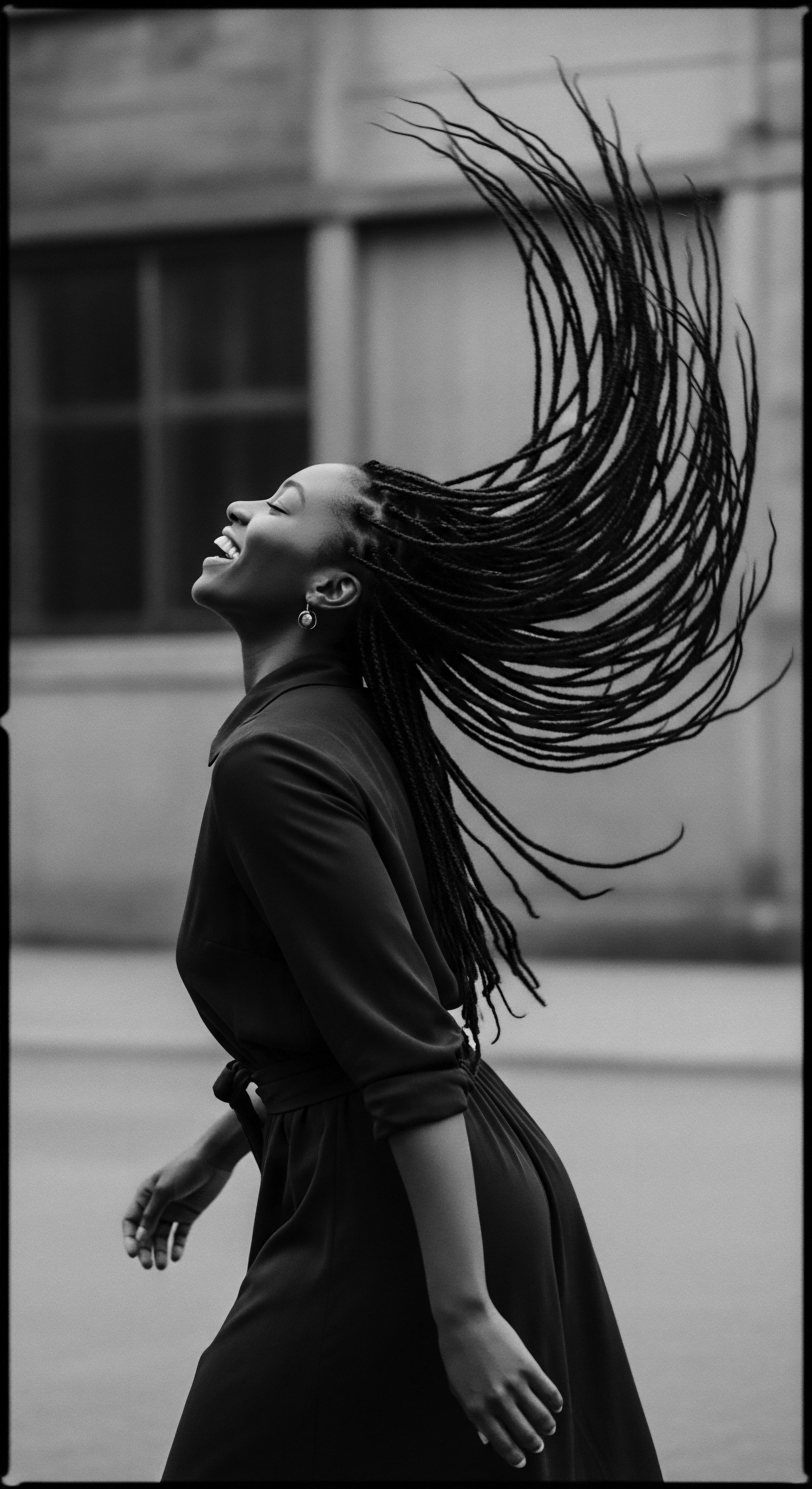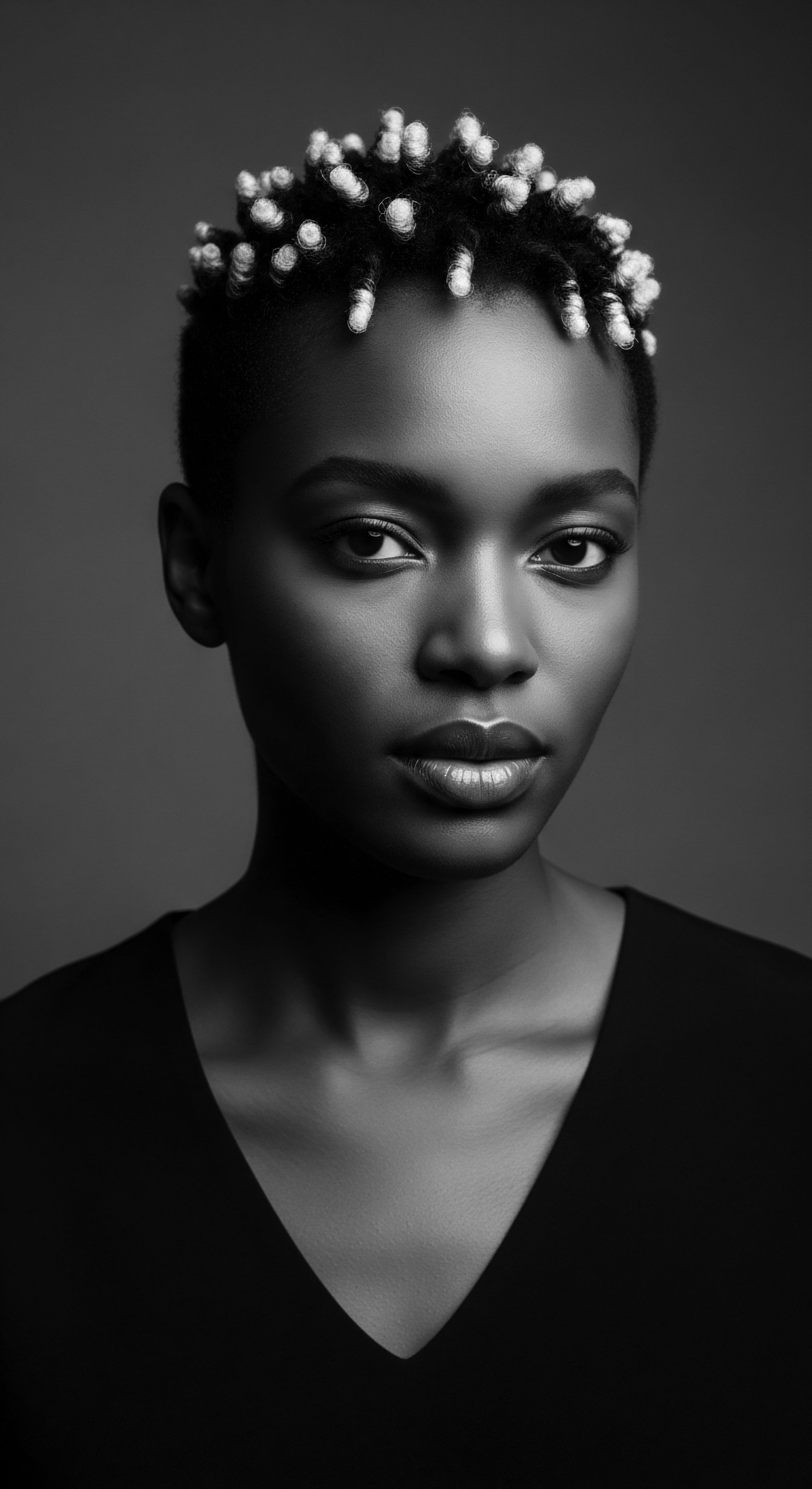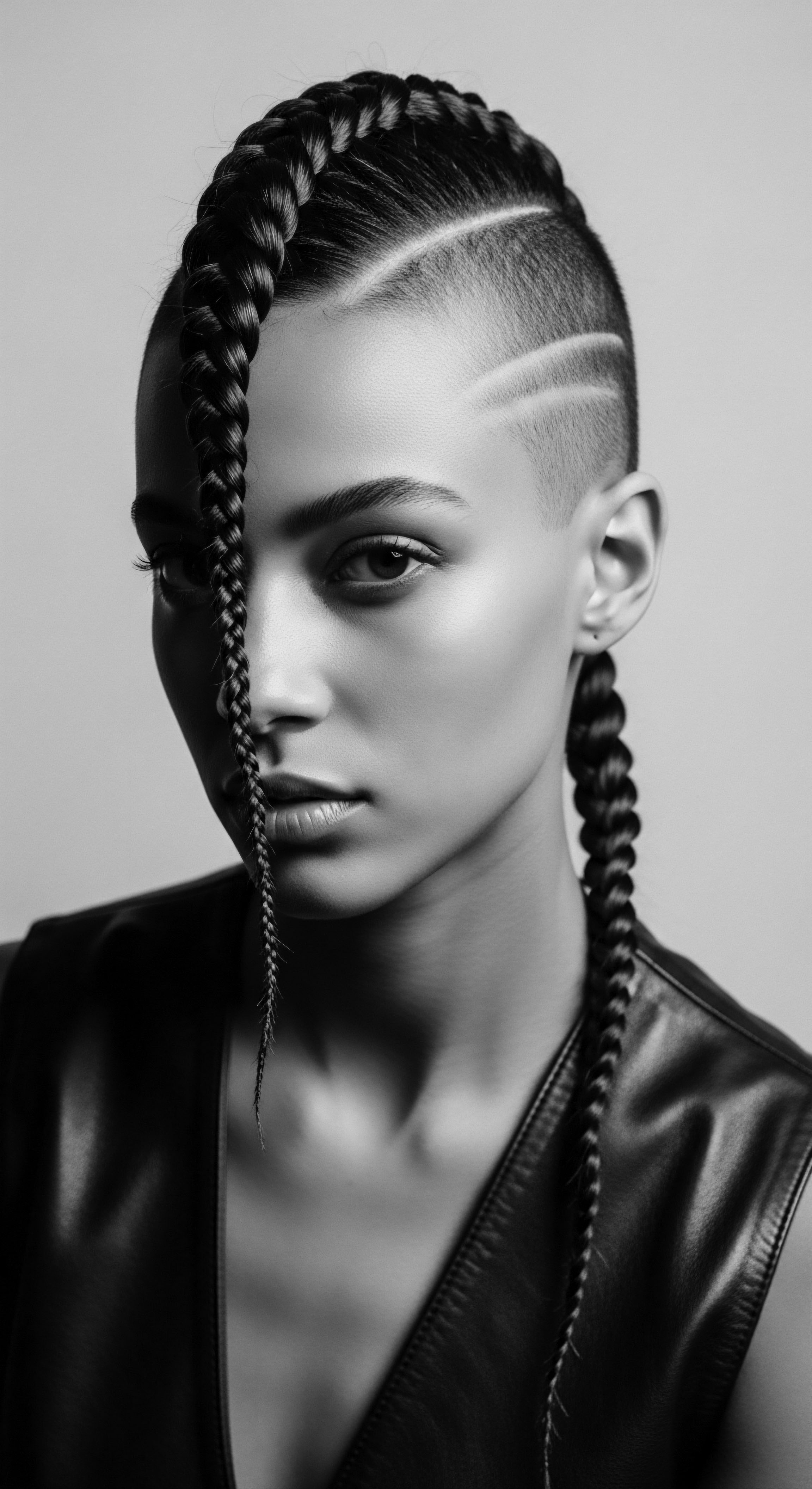
Roots
To stand upon the precipice of understanding how protective styles aided survival during enslavement, we must first allow our senses to reach back, beyond the immediate grasp of the present, toward the distant shores of West Africa. There, before the great wrenching, hair was not a mere adornment; it served as a living archive, a visible chronicle etched upon the scalp. Ancestral African societies, with their intricate social structures, viewed hair as a profound symbol of identity, status, marital standing, age, and even spiritual connection. The very coils and textures, the particularity of each strand, held meaning within communities.
The resilience inherent within textured hair, its unique helical structure, offered an elemental advantage. This hair, with its inherent coil and robust nature, naturally resists moisture loss more effectively than straighter textures, a biological trait rooted in human evolution for protection from the sun’s intense ultraviolet rays. This natural attribute, a gift of deep time, became a silent ally.
When individuals were violently captured, their heads often shaved as a dehumanizing act, a brutal severing of cultural ties and personal dignity, a systematic erasure of identity. Yet, even in this act of profound violence, the fundamental biology of textured hair persisted, ready to respond to ancestral knowledge and ingenuity.
The deep history of textured hair reveals its ancient role as a cultural compass, each style a silent marker of identity and belonging.
Consider the practices of pre-colonial West Africa, where hairstyling was an elaborate ritual, a communal gathering. Hands moved with purpose, weaving stories and status into coily strands. Natural butters and oils, derived from indigenous plants, were applied with knowledge passed through generations, providing nourishment and guarding against breakage.
These practices, born of necessity and wisdom, formed the very foundation for how hair would be managed in the harrowing conditions of enslavement. The understanding of hair’s anatomy, its specific needs for hydration and gentle handling, was a deep, inherited wisdom that would later prove invaluable.

How Did Ancestral Hair Understanding Aid Survival?
The knowledge of hair’s particular needs, passed down through oral traditions, was a form of unwritten science. This understanding guided the selection of materials available on plantations, often repurposed for hair care. Women, forced into unimaginable labor, found ways to cleanse and tend to their hair, often using rudimentary tools crafted from wood or bone, and natural fats or oils as moisturizers.
The tightly coiled nature of textured hair, often perceived as a challenge by those unfamiliar with its needs, was a gift when resources were scarce. It allowed for styles that held their shape, reducing the daily manipulation that would otherwise lead to extensive damage and loss.
- Indigenous Oils ❉ Shea butter and coconut oil, familiar to many West African cultures, were used when available to hydrate and seal moisture into strands.
- Hand-Crafted Tools ❉ Combs and picks, fashioned from scavenged wood or bone, continued the tradition of meticulous hair care.
- Headwraps ❉ Cloth pieces, sometimes dyed with natural pigments, offered physical shielding from sun and debris, while also serving as a visual statement of identity and status.
The capacity of textured hair to be manipulated into various protective shapes—braids, twists, cornrows—without heat or harsh chemicals was a biological blessing. These styles, practiced for millennia across African societies, became fundamental for maintaining hygiene and minimizing the physical toll of grueling labor. They reduced tangling, preserved length, and offered a modicum of relief from insects and harsh weather conditions, proving that even in the face of brutal oppression, the very physical attributes of heritage held powerful, practical benefits.

Ritual
Within the chilling reality of enslavement, the deliberate styling of hair transcended mere aesthetics. It became a powerful, albeit quiet, ritual of survival, a defiance etched in each braided strand. The practice of protective styling transformed into a silent language, a covert network of communication and a means to carry tangible hope. These styles, some ancient in their lineage, offered practical advantages under conditions of immense hardship.
One of the most profound and unique ways protective styles aided survival was through the concealment of sustenance and information. Enslaved African women, particularly those with agricultural knowledge, braided rice seeds, small grains, or even gold fragments into their hair before forced migration or while working in fields. This extraordinary act, often passed down through oral histories, allowed for the clandestine transport of vital crops from their homelands or a source of sustenance during escape attempts.
A striking oral tradition from Suriname, documented by scholars like Judith Carney (2020), speaks of an enslaved African woman who introduced rice to the Americas by hiding grains in her hair upon disembarking the slave ship, enabling her descendants to sustain themselves in plantation societies. This account, supported by research into the origin of rice species in the Americas, highlights the ingenuity and forethought woven into these styles.
Protective styles transformed hair into a clandestine vessel for seeds and coded messages, aiding both physical sustenance and the journey toward freedom.
The styles themselves, particularly cornrows, also served as a secret cartography. Intricate patterns, reminiscent of those used in pre-colonial Africa to denote social standing or tribal identity, were adapted to outline escape routes, map trails, indicate water sources, or mark meeting points for those seeking freedom. The zigzags might point to a river, a particular number of braids might signal a designated gathering spot. This communication, invisible to the enslavers, was a testament to the collective intellect and courage of those yearning for liberty.
Beyond these overt acts of resistance, protective styles offered everyday physical preservation for textured hair. The grueling conditions of plantation life—sun, dust, manual labor—would have severely damaged hair left exposed. Styles like cornrows, twists, and Bantu knots tucked hair away, limiting environmental exposure and minimizing breakage. They kept hair tidy and prevented excessive tangling, a significant practical consideration given the scarcity of proper cleansing agents and tools.
| Protective Style Cornrows |
| Survival Mechanism Used as coded maps for escape routes; concealed seeds for sustenance during flight. |
| Heritage Connection Ancient African braiding tradition, dating back thousands of years, with roots in West African communication systems. |
| Protective Style Twists |
| Survival Mechanism Minimized tangling and breakage; practical for long workdays with minimal upkeep. |
| Heritage Connection Traditional African method for managing coiled hair, often used for spiritual purposes or to denote status. |
| Protective Style Bantu Knots |
| Survival Mechanism Protected hair ends; maintained moisture and length; offered a method for hygienic preservation. |
| Heritage Connection Originated with the Zulu tribe of South Africa as symbols of femininity and beauty. |
| Protective Style These styles, rooted in African heritage, became vital instruments for both physical well-being and resistance during enslavement. |

What Communal Aspects Supported Hair Care?
The ritual of hair care also provided moments of clandestine community. Sundays, often the sole day of rest, became precious opportunities for enslaved people to attend to their hair, braiding for themselves and one another. These sessions, though brief, were more than just grooming; they were shared spaces where stories were exchanged, solace found, and hope quietly nurtured. They were times when ancestral knowledge was transmitted, not just about hair care, but about survival, culture, and enduring spirit.
This communal aspect fostered bonds, reinforcing a collective identity that the system of enslavement sought to dismantle. The act of tending to another’s hair, a gesture of intimacy and care, became a powerful, silent affirmation of humanity in the face of brutal dehumanization.
The resourcefulness displayed in creating hair tools and products from available materials speaks volumes. Animal fats, plant extracts, and even discarded items were ingeniously repurposed, reflecting an ancestral connection to the land and a deep understanding of natural properties. This practical heritage allowed for continued hair health and a visible link to their origins, even under the most dire circumstances.

Relay
The enduring influence of protective styles, born of necessity and ancestral wisdom during enslavement, extends far beyond physical preservation; it profoundly shaped the cultural psychology and collective resistance of African descendants. This section explores how these styles, as a living legacy, continue to inform practices and perspectives within textured hair heritage, revealing deeper layers of resilience and ingenuity.
Beyond the physical mechanics of hair preservation, these styles were psychological bulwarks. They served as a constant, tangible link to a shattered past, reminding individuals of their identity and heritage when all efforts sought to strip it away. The very act of maintaining one’s hair in traditional forms, however simple, was a quiet assertion of selfhood.
It was a refusal to fully conform to the imposed ideals of European beauty, which often privileged straight hair and darker skin for field labor, lighter skin and straighter hair for domestic roles. This subtle act of self-determination, often under the very gaze of enslavers, was a powerful act of resistance.
The heritage of protective styles, beyond physical preservation, shaped collective identity and cultural resistance for generations.
The psychological benefits cannot be overstated. In a system designed to induce hopelessness, the continuity of hair practices provided a thread of normalcy, a connection to a life that had value and meaning. These practices offered moments of introspection, of connection with ancestral spirits, and a quiet dignity that was deeply personal. This personal fortitude contributed directly to collective endurance.

How Does Modern Science Echo Ancestral Wisdom?
Contemporary understanding of hair science validates much of the ancestral wisdom embedded in protective styling. Modern trichology confirms that minimizing manipulation, avoiding excessive heat, and retaining moisture are pillars of hair health, particularly for tightly coiled strands. The practice of braiding, twisting, and coiling hair to tuck away delicate ends and protect the shaft from environmental stressors mirrors scientific recommendations for mitigating breakage and promoting length retention.
- Minimized Manipulation ❉ Reduces physical stress on the hair cuticle, preventing breakage and split ends.
- Moisture Retention ❉ Styles that keep hair tucked away help to seal in natural oils and applied moisturizers, which is vital for dryness-prone textured hair.
- Scalp Access ❉ Many protective styles allow for direct access to the scalp, enabling cleansing and application of nourishing oils for scalp health.
The historical use of natural ingredients like shea butter and various plant oils by enslaved people finds a parallel in today’s natural hair care industry, where these very components are celebrated for their proven benefits. This demonstrates a continuity of knowledge, where ancient practices are now understood through the lens of modern scientific inquiry, reinforcing the profound ancestral expertise.
The narratives surrounding these practices have been passed down through generations, often orally, maintaining a vibrant connection to the experiences of those who endured enslavement. These stories, coupled with archaeological and ethnobotanical research, provide a rich understanding of the resilience that characterized the Black diaspora. For example, research into the botanical legacies of enslaved Africans in the Circum-Caribbean region shows how they established plants valued for food, medicine, and religious practices in the New World, often relying on seeds brought in covert ways, including in their hair. This systematic botanical transfer, alongside hair care, highlights an active, informed agency in shaping their new environment for survival.

What Is The Legacy of Hair as Resistance?
The legacy of protective styles as tools of resistance is powerful. In an era where laws like the Tignon Law in Louisiana (1786) sought to mandate head coverings for Black women, protective styles, often beneath scarves, became a further layer of subtle defiance. While the law aimed to differentiate Black women from white women in public, the act of covering hair, though forced, also allowed for the preservation of intricate, culturally significant styles underneath, known only to the community. This duality—outward conformity with inward cultural preservation—is a hallmark of survival strategies during oppression.
The continuity of these hair practices into the modern era speaks volumes about their enduring significance. They represent not just a means of hair maintenance, but a profound connection to ancestry, a celebration of resilience, and a visible manifestation of cultural pride. The textured hair movement of today, while contemporary, stands upon the shoulders of those who, against unimaginable odds, kept these traditions alive, ensuring that the soul of a strand would continue its narrative through time.
| Historical Significance Covert communication for escape and survival. |
| Contemporary Relevance Symbol of cultural pride and connection to ancestral resistance. |
| Historical Significance Physical preservation of hair in harsh labor conditions. |
| Contemporary Relevance Foundation of modern protective styling for hair health and length retention. |
| Historical Significance Maintenance of cultural identity against forced erasure. |
| Contemporary Relevance Celebration of natural beauty, challenging Eurocentric standards. |
| Historical Significance The strategies of the past continue to shape the practices and meaning of textured hair today. |
The study of hair during enslavement reveals a deeper truth ❉ survival was not solely about the breath in one’s lungs, but about the spirit of a people remaining intact. Protective styles, therefore, were never just about hair. They were about the intricate interplay of biological function, ancestral wisdom, communal support, and a profound, silent determination to survive with one’s heritage, however challenged, still living.

Reflection
The journey through the history of protective styles during enslavement is a profound exploration of human tenacity and the unyielding spirit of heritage. It is a testament to how even the most intimate aspects of self—our hair—can become sites of profound meaning, resistance, and survival. The coiled strands, often dismissed or derided, proved to be an unexpected repository of wisdom, a canvas for coded messages, and a practical shield against relentless adversity.
This chronicle of hair is a living archive, reminding us that knowledge is not always confined to written pages or grand pronouncements. Sometimes, it resides in the skilled hands that braid, in the quiet conversations shared during communal hair care, and in the very biology of a people’s hair. The ingenuity displayed by enslaved ancestors in leveraging their hair for physical well-being, for the transport of life-sustaining seeds, and for the clandestine mapping of freedom routes, speaks to a depth of wisdom that transcends time. This is the very Soul of a Strand ❉ a resonant echo of struggle, a silent song of defiance, and a vibrant affirmation of enduring identity.
In every textured strand, in every protective coil and twist, we find a direct connection to a past that was characterized by both unspeakable suffering and extraordinary strength. It is a legacy that urges us to remember, to honor, and to understand that our hair, in its myriad forms, carries not just history, but the luminous promise of ongoing resilience and cultural pride. This enduring narrative, written strand by strand, continues to shape our understanding of beauty, wellness, and the inextinguishable light of human heritage.

References
- Carney, Judith A. 2020. ‘With Grains in Her Hair’ ❉ Rice in Colonial Brazil. Journal of Latin American Geography 19, no. 1 ❉ 15–40.
- Byrd, Ayana, and Lori L. Tharps. 2014. Hair Story ❉ Untangling the Roots of Black Hair in America. New York ❉ St. Martin’s Press.
- Hooks, Bell. 2003. Hair Story ❉ Untangling the Roots of Black Hair in America. In Teaching Community ❉ A Pedagogy of Hope. New York ❉ Routledge.
- White, Deborah Gray. 1999. Ar’n’t I a Woman? ❉ Female Slaves in the Plantation South. New York ❉ W.W. Norton & Company.
- Rubin, Richard. 2007. The History of the Black Hair Care Industry ❉ A Timeless Struggle for Beauty. Chicago ❉ Moody Publishers.
- Penniman, Leah. 2020. Farming While Black ❉ Soul Fire Farm’s Practical Guide to Liberation on the Land. White River Junction, VT ❉ Chelsea Green Publishing.
- Kelley, Robin D. G. 1990. Hammer and Hoe ❉ Alabama Communists During the Great Depression. Chapel Hill ❉ University of North Carolina Press.
- Siegel, Stephen. 2017. Black Hair ❉ A Cultural History of Hair Fashion in Black Communities. Minneapolis ❉ Lerner Publications.
- Walker, Alice. 1970. In Love and Trouble ❉ Stories of Black Women. New York ❉ Harcourt Brace Jovanovich.
